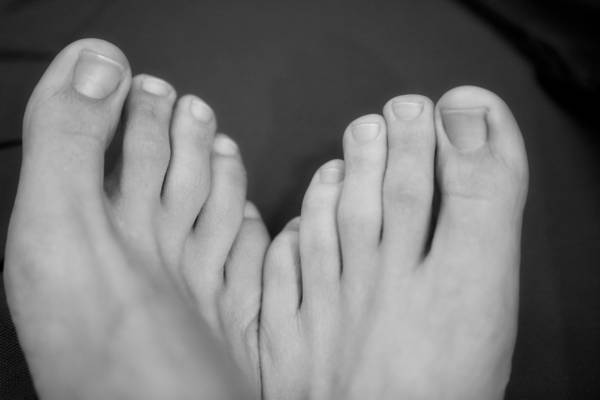My teenage boy keeps getting ingrown toenails. What’s the best thing to do, and can they be prevented?
Yes, they can be prevented. What usually happens is that your son won’t complain until his toe is markedly swollen and tender, and then we end up seeing them. By then, the time for simple, conservative treatment has passed, and we’ll need to do something more aggressive, and probably painful. Get in the habit of checking out your child’s feet every couple of weeks or so, and you’ll catch this before it gets too far along.
Ingrown toenails are way too common, and usually involve the great toes. They start when a small, sharp piece of the nail burrows into the skin and causes inflammation, swelling, and pain. With enough time, they’ll become infected and may start to drain. Frequent causes are poorly fitting shoes (too tight), improper nail trimming, and occasionally some mild trauma, such as a “stumped toe.” But by far the most common cause is improper trimming. Toenails should never be trimmed with fingernail clippers. Never. Fingernail clippers are curved, and invite the edges of the toenail to dig into the skin border and start this process. Toenails should be trimmed with something straight, and not trimmed too closely. The end of the nail should always be free of any skin or we’re just inviting trouble. Invest in some toenail clippers and make sure they’re straight.
Now that you’re going to check your child’s toes every couple of weeks, what are you going to be looking for? Again, some redness and swelling along the edge of the nail, and tenderness. Catch this early, and you can turn it around. Start with some warm, soapy water and soak the foot for 10 to 20 minutes three or four times a day. Sounds like a lot, and it is. But this will help. When the skin around the nail is soft from the soaking, gently push the edges back from the nail, a little at a time. You can use a Q-tip or one of the blunt objects that frequently comes with a nail-trimming kit. The idea is to free the end of the nail from the adjacent skin, preventing the burrowing under that causes the problem. We tell our patients to try to place a wedge of gauze or a piece of cotton under the nail, or even a piece of dental floss. Anything to keep the end of the nail free. There’s even a technique that describes lifting the nail with a piece of cotton and then applying skin glue to form a kind of “cast.” You can leave this in place until it falls off on its own. Whatever it takes, and whatever you’re comfortable doing. In the movie Braveheart, the mantra was “Free-dom!” Here, it’s “Free the Nail!” And you don’t have to wear a kilt. The important fact is that more than 70 percent of toes will respond to this kind of conservative therapy, so try to do something.
But if it’s too late for that, and your teenager’s great toe is swollen, red, and he can barely walk on it, it’s time to do something more.
This is going to require some effective local anesthesia, usually in the form of a “nerve block”—injecting an anesthetic that deadens the nerves that run on the outside of each toe. There’s no magical way of doing this, and it’s going to hurt. But then it’s done, and your child’s not going to feel anything further.
What about using some of that numbing cream?
The most frequently used is call EMLA and it doesn’t work, not on toes. We’ve got to block those nerves.
The next step is to take some sharp, straight scissors (or similar instrument) and remove a wedge of the nail all the way back to the base. Once that’s done, any infected material needs to be removed, along with any “proud flesh.” This is simply exuberant granulation tissue that spills over the nail and has to be gotten rid of. Trimming it away works, and then we “cauterize” it with a silver nitrate stick. This leaves the area blackened, but the discoloration will wear off in a couple of days. Twice daily antibiotic cream and a covering bandage will be needed for several days, and the toe will need to be kept clean and dry. Oral antibiotics might be needed, depending on the presence and extent of infection, and acetaminophen/ibuprofen will usually handle the pain. Once we’ve gone to all this trouble (and pain!) we want to be sure that our child is wearing the correct shoes, trimming their nails correctly, and letting you know of any early redness and swelling.
Sometimes this will come back and will frequently need an even more aggressive approach. The nail will need to be “wedged” again, but this time the base (where the nail grows from) will have to be destroyed, either with a laser treatment or a chemical (phenol). This will need to be done by an orthopedist or podiatrist. While not terrible, this is something we all want to avoid. And it can be. As we said earlier, ingrown toenails can be prevented. Just pay attention.
…
This is an excerpt from the new book I’m writing with pediatrician Dr. Robert Alexander. The book will address 100 questions from parents regarding their children’s health. Feel free to email us with questions: askthedox@yahoo.com


Add Comment